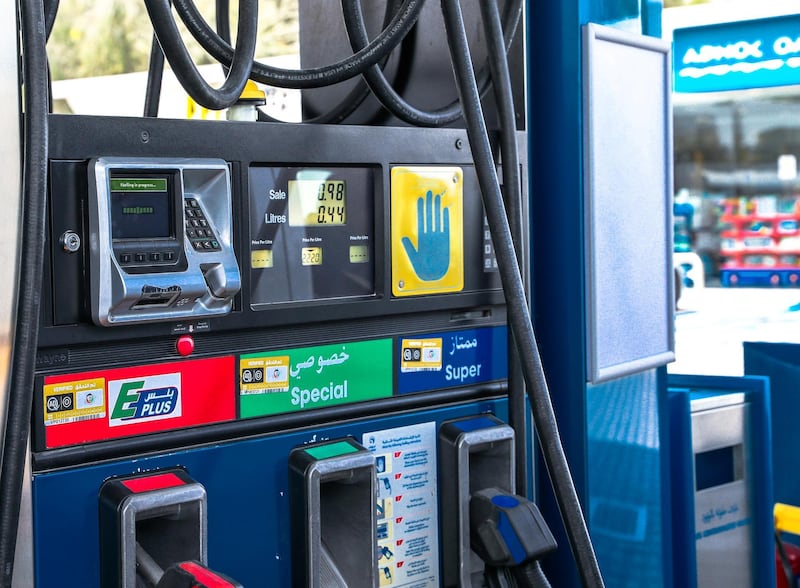Oil above $75 a barrel is good for Middle East economies but a challenge for the region’s energy reformers and consumers.
Slumping prices had triggered a wave of new policies over the last four years to slash subsidies on petrol and electricity, while boosting investment into renewables. Maintaining the momentum behind energy market liberalisation is essential for future prosperity.
Previously, the region’s consumers were insulated from higher oil prices by generous state subsidies, which were costly to maintain and encouraged waste.
The UAE opened the flood gates three years ago by introducing a new pricing model for gasoline and diesel in August 2015, when a barrel of Brent crude was trading at $54. Since then a fuel committee has set gasoline prices based on a monthly review of global averages and operating costs instead of historically unsustainable subsidies.
At the time, a liter of 98 octane petrol bought at a filling station on Sheikh Zayed Road would cost Dh1.83. Today, the same quantity of fuel will cost motorists Dh2.63, up 44 per cent from the subsidised rate.
Despite concerns voiced by the region’s consumers, the UAE’s example was quickly followed by many Arabian Gulf neighbors. Oman’s Ministry of Finance revealed plans to follow later in the same year. Saudi Arabia – the region’s largest economy and biggest producer of crude – followed a few months later by raising the price of petrol by 66 per cent as part of a programme of economic reforms to rein in its budget deficit.
Although consumers in the region still benefit from low tax rates, these price increases have been about in line with the international wholesale market. S&P Global Platts’ data show the FOB Singapore 95 RON Middle East petrol price hit a low of almost $37 per barrel in February 2016, before steadily climbing to close to $80 per barrel in June 2018, in synch with the rise in Brent crude prices.
Transport fuel is also just a small part of the story. Subsidies have been removed, or are in the process of being reduced, on electricity and desalinated water supply across the region. Meanwhile, investment into renewable sources of energy has never been higher, or needed to be before the slump in oil prices hit government coffers. Up to $40 billion of investment will be required for the Middle East as a whole to meet its renewable energy targets by 2035.
However, transforming the retail petrol and diesel market has caused the most pain in a region where motorists had grown accustomed to the cheap cost of filling up. The net economic benefit of these reforms – despite their sensitivities – is profound. In 2014, the International Monetary Fund (IMF) estimated that pre-tax subsidies were costing the Middle East and North Africa region $237bn annually, equivalent to almost a quarter of all government revenues at the time.
_______________
Read more:
Middle East bunkers provide safe port in IMO 2020 storm
Russia and Saudi Arabia have the clout to persuade Opec nations to agree to new quotas
_______________
Instead of doling out handouts, the IMF argues “transparent and simple formulas to adjust prices have shown to be more conducive to successful and sustainable reform,” adding that “automatic price mechanisms can help depoliticise the reform process, help avoid reform reversal, and facilitate the transition to a fully liberalised pricing system.”
However, with oil prices recovering, the pressure to push through faster energy reforms could ease. In Saudi Arabia, domestic petrol prices will now reach parity with international levels gradually through to 2025 - compared to the previous target of 2020, according to last year’s budget statement. The kingdom has increasingly dragged its feet on further reforms despite its desire to reduce its economic dependence on oil as part of the Vision 2030 plan.
Prior to fuel price reforms, the Middle East was one of the world’s fastest-growing and most wasteful markets. Domestic consumption of crude in the region rose by almost 50 per cent to 8.7 million barrels per day in the decade leading up to 2014 and the start of the oil market slowdown. However, demand growth has since slowed down in line with the introduction of policies, which are also designed to encourage be more prudent.
“Low energy prices encourage wasteful and excessive consumption, and they inhibit energy efficiency. Keeping energy prices low also discourages investment in the energy sector, locking in inefficient technologies and affecting energy production,” said the IMF.
The worst thing for the IMF would be if the Middle East’s Opec governments were to ease back on subsidy reforms after winning their battle to rebalance oil markets. Now is not the time for turning.
Paul Hickin is associate director for oil and Andy Critchlow is head of energy news, Emea at S&P Global Platts






